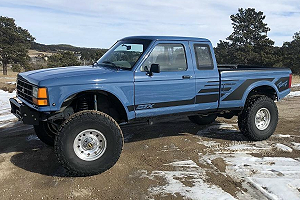Personally I think window unit looks sloppy and shouldn't be put on a vehicle except in a few special cases. Namely a van or box truck that is converted into a mobile office/work space or camper. Then it should be plugged into an normal AC outlet, or should be run off a battery bank and inverter, not off of engine power and inverter. That's my 2 cent on the window unit.
As for repairing the AC, you know you need a compressor. You also need a reciever/dryer, they contain a dessicant material and will go bad if exposed to atmosphere for long. With the compressor gone the system is open and yours has been exposed way too long. You could install those and try your luck, but I wouldn't. Since you don't know the condition of the system, I'd replace everything. Here's why...
You don't know what happened to cause PO to remove the compressor. If the compressor died violently it's likely contaminated the rest of the system (look "A/C Black Death") and can be almost impossible to clean out. If this is in the system, it is likely to either block the tiny passages in the condenser (behind grill) and evaporator (on firewall), or block up the oriface tube screen. It could also turn loose and damage the new compressor and other parts.
If you have any leaks in the system, you would be wasting freon which isn't cheap. With an assembled system you can test of leaks with vacuum, but the only way to really find those leaks is with a charged system and leak detect dye. Again wasting freon and money on paying a shop to do all of this.
You may be converting from R12 (no longer available) to R134 (it's replacement). When doing this it is best to replace all of the o-rings in the system to ones that are compatible with R134, otherwise the new stuff could cause the old seals to break down. At it's age, it would be a good idea to put all new seals in anyway.
With what you are already spending, the additional parts don't cost that much more. By the time you pay a shop to do all of the potential troubleshooting, you could have paid for all new components. Install them yourself, easily doable since the system is already discharged, and add required oil in correct amount during assembly (there are instructions around). Then you only need to pay the shop for freon and charging the system. Just if you do this, leave the compressor electrically disconnected until it is serviced. It shouldn't run until serviced anyway, but better safe than sorry.













